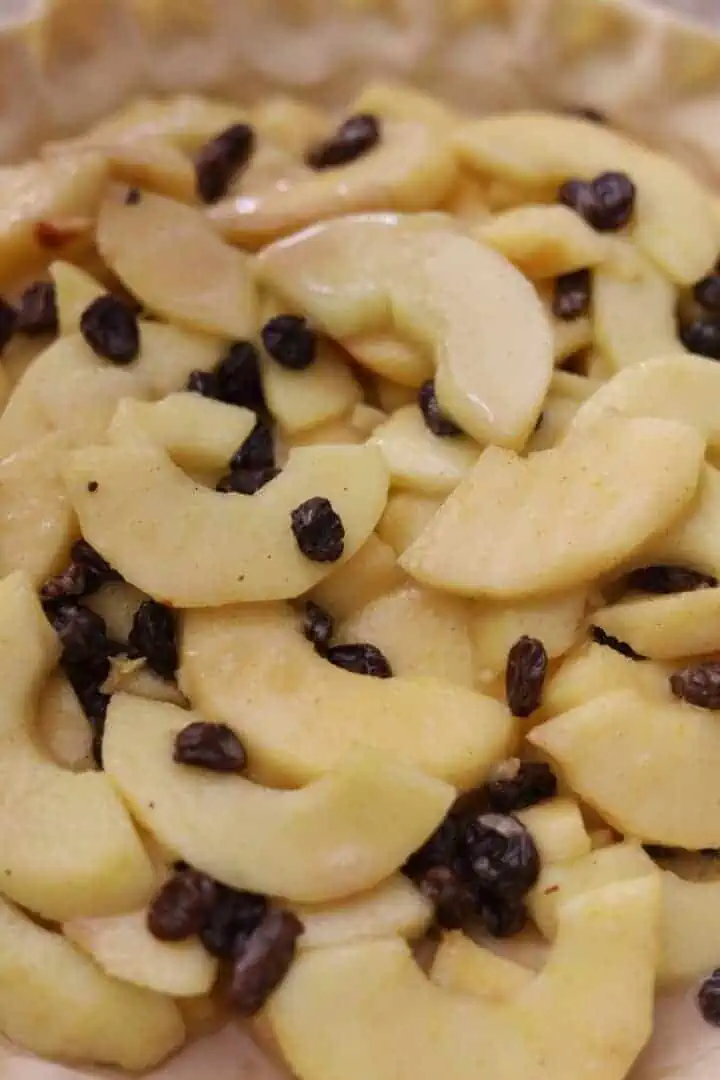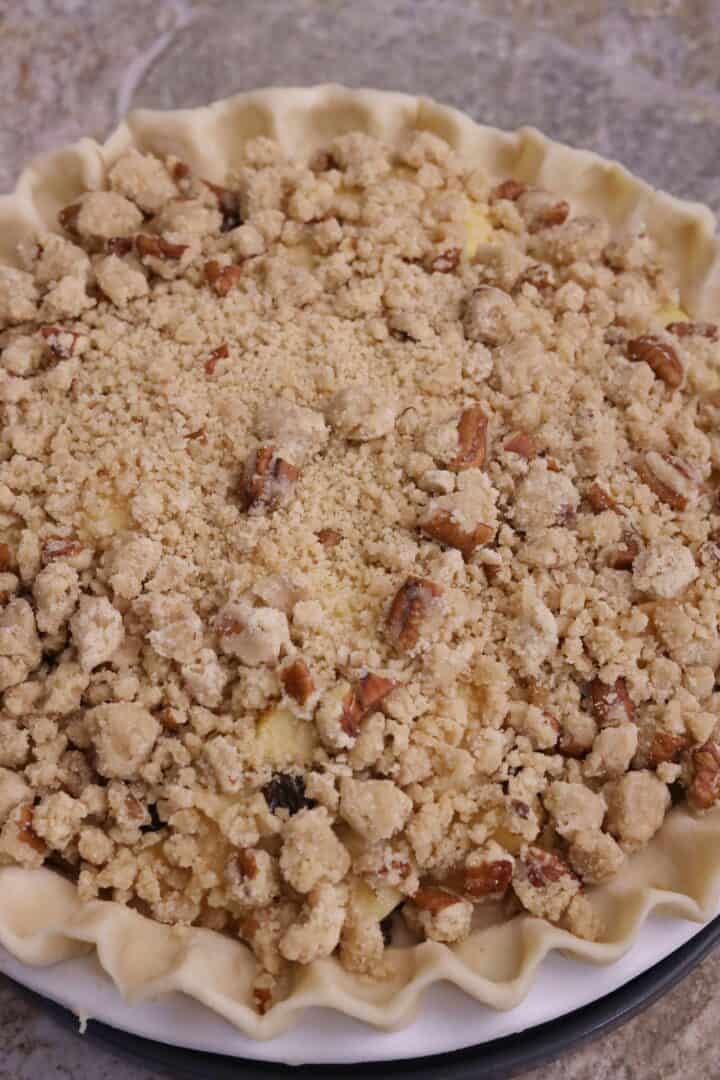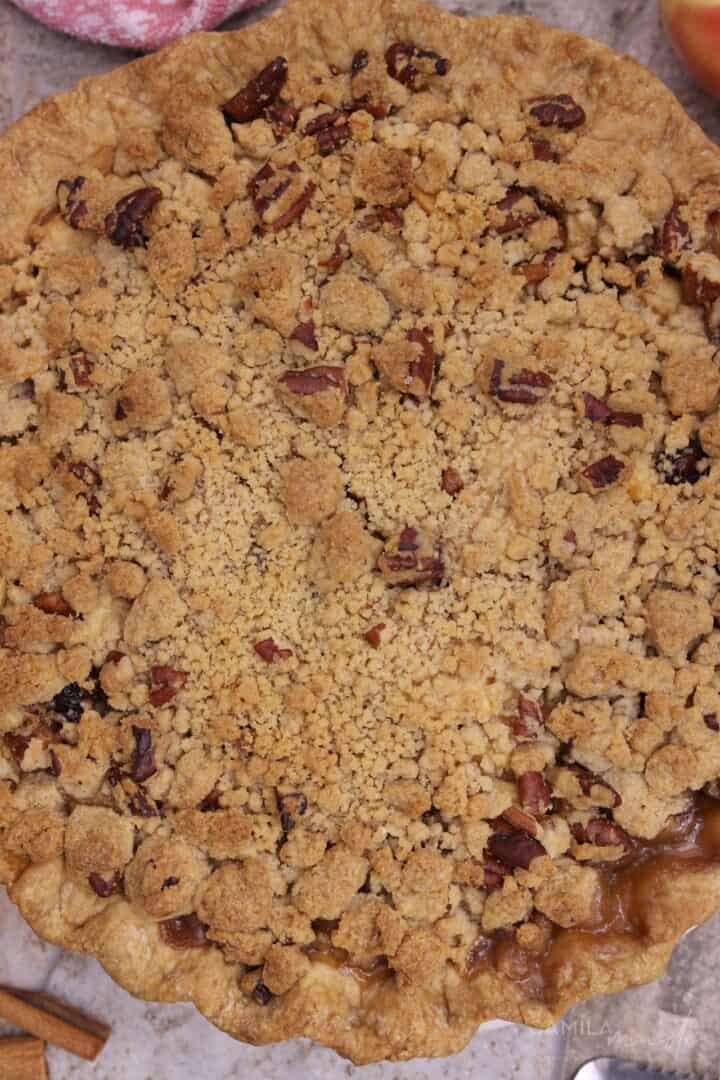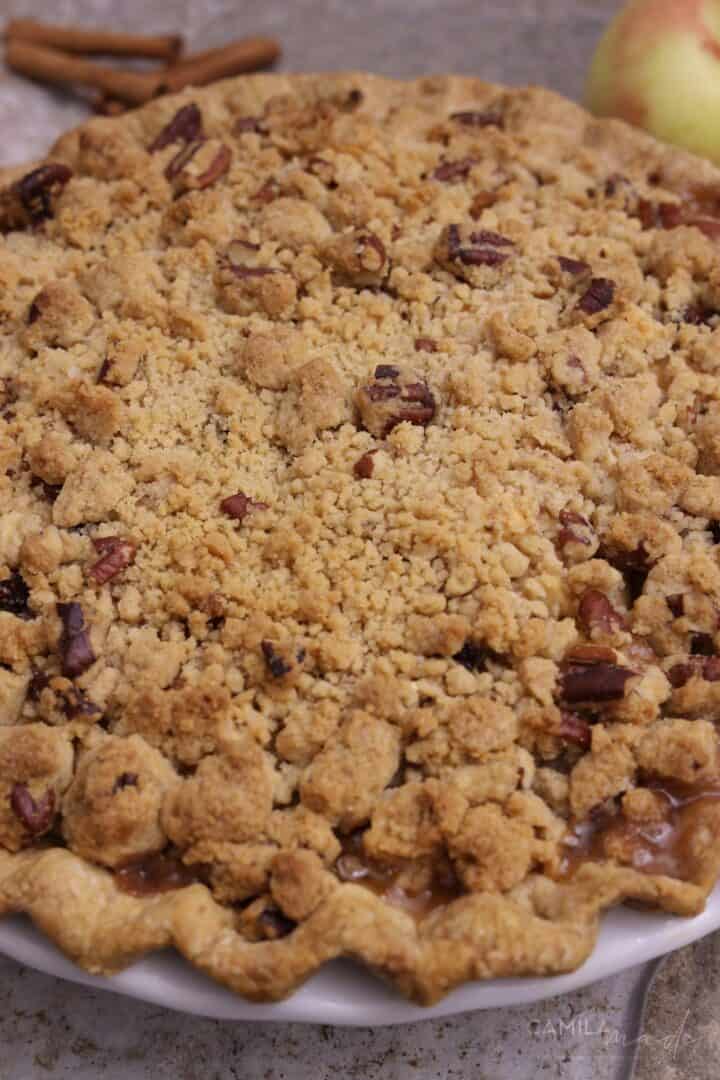Dutch apple pie, also known as apple crumb pie, is a classic dessert loved by people of all ages. It is a delicious and comforting pie that is perfect for any occasion, from a casual weeknight dinner to a special holiday meal. This recipe is easy to follow and produces a perfect Dutch apple pie every time.
The key to a great Dutch apple pie is to use a variety of tart apples, such as Granny Smith and Braeburn. These apples will give the pie a delicious balance of sweet and tart flavors. The crumb topping is also an important part of the pie. It gives the pie a crunchy texture and adds extra flavor. Dutch apple pie is best served warm with a scoop of vanilla ice cream or whipped cream or with a cup of coffee for a classic pairing.
 What is Dutch Apple Pie?
What is Dutch Apple Pie?
Dutch apple pie, also known as appeltaart in Dutch, is a traditional Dutch dessert made with apples, pie crust, and a streusel topping. The pie crust is typically made with flour, butter, sugar, and salt, and it is pressed into a springform pan. The apples are peeled, cored, and sliced, then tossed with sugar, flour, cinnamon, and lemon juice. The apple mixture is poured into the prepared pie crust, and the streusel topping is crumbled over the top.
The streusel topping is made with flour, sugar, butter, and spices. It is sometimes also made with nuts or oats. The streusel topping gives the pie a crunchy, caramelized topping that contrasts nicely with the soft, juicy apples.
Dutch apple pie is typically baked for about 45-55 minutes or until the crust is golden brown and the apples are tender. The pie is then allowed to cool completely before slicing and serving. Dutch apple pie is a popular dessert in the Netherlands, and it is also enjoyed in many other countries worldwide. It is often served with a scoop of ice cream or whipped cream.
What's the Difference between Dutch Apple Pie and Apple Pie?
The main difference between Dutch apple pie and apple pie is the topping. Dutch apple pie has a crumbly streusel topping, while apple pie typically has a top layer of regular pie crust.
Another difference is that Dutch apple pie is often baked in a springform pan, while apple pie is typically baked in a pie plate. This gives Dutch apple pie a deeper dish and a more rustic look.
Finally, Dutch apple pie filling often includes raisins, while apple pie filling typically does not. However, this is not always the case, and there are many different recipes for both types of pies.
,You can also use a mix of different apple varieties to create a more complex flavor profile. For example, you could combine Granny Smith apples for tartness with Honeycrisp apples for sweetness.
When choosing apples for Dutch apple pie, it is important to avoid varieties that are too juicy, or that tend to break down when baked. These types of apples will result in a runny pie filling.
Camila's Tips for choosing the best apples for Dutch apple pie:
Look for apples that are firm and have a smooth skin.
Avoid apples that are bruised or have soft spots.
Choose a mix of different apple varieties to create a more complex flavor profile.
Avoid varieties that are too juicy or that tend to break down when baked.Once you have chosen your apples, be sure to peel, core, and slice them thinly. This will help the apples to cook evenly and prevent the pie filling from becoming too runny.
More About This Dutch Apple Pie Recipe
This Dutch apple pie recipe is a classic autumn dessert that is easy to make and delicious. It is made with a homemade buttery and crisp pie crust, two varieties of apples (Granny Smith for tartness and Honeycrisp for sweetness), and a flavorful filling of heavy cream, sugar, and warm spices. The apple filling is layered in the pie crust and topped with a tasty pecan streusel topping before being baked until golden brown.
Dutch Apple Pie Ingredients
Note: The full ingredients list is provided in the recipe card below.
Dutch Apple Pie Crust:
- All-purpose flour: Forms the base of the pie crust.
- Sugar: Adds a touch of sweetness to the crust.
- Kosher salt: Enhances the overall flavor and balances sweetness.
- Cold unsalted butter: Provides flakiness and richness to the crust.
- Cold vegetable shortening: Contributes to the crust's tenderness and flakiness.
- Pure vanilla extract: Adds flavor to the crust.
- Ice-cold water: Helps bind the ingredients and hydrate the dough.
Dutch Apple Pie Filling:
- Mixed baking apples: Compose the main filling of the pie, providing sweetness and texture.
- Freshly squeezed lime juice: Adds a tartness that complements the sweetness of the apples.
- Granulated sugar: Sweetens the filling and helps to release juices from the apples.
- Light brown sugar: Adds a caramel-like sweetness and moisture to the filling.
- Kosher salt: Enhances the overall flavor and balances the sweetness.
- Cinnamon: Infuses warm and aromatic spice notes.
- Freshly grated nutmeg: Provides a warm and nutty flavor.
- Pure vanilla extract: Enhances the overall flavor of the filling.
Streusel Topping:
- All-purpose flour: Forms the base of the streusel topping.
- Ground cinnamon: Provides warm and spicy notes to the topping.
- Grated nutmeg: Adds a nutty and aromatic element to the topping.
- Light brown sugar: Sweetens and caramelizes the streusel topping.
- Granulated sugar: Adds sweetness and texture.
- Melted butter: Binds the streusel ingredients together and contributes richness.
- Nuts: We use toasted pecans for the streusel, but you can use toasted walnuts if you'd like. [Click on the link for a guide on How to Toast Nuts.]
Tools you'll need
- (1) 9-inch deep pie pan
- half-sheet pan
- Liquid Measuring Cups
- Dry Measuring Cups and Spoons
- Silicone Spatula
- Mitten Oven
- Wire rack
- Food Processor or Pastry blender
How to Make Dutch Apple Pie
Note: The full instruction is provided in the recipe card below.
For the Crust: Dice the unsalted butter and shortening and place it in the freezer; while preparing the flour mixture in a food processor fitted with a steel blade, pulse flour, salt, and sugar to combine, about 5 seconds. Add the chilled butter and shortening pieces and pulse until the mixture resembles a coarse crumble with only a few larger pieces, about 10 pulses. In a small bowl, combine 3 tablespoons of ice water and 1 tablespoon of pure vanilla extract.
With the machine running, pour the ice water mixture down the feed tube and pulse the machine until the mixture forms clumps and no dry flour remains, about 12 pulses, scraping down the sides of the bowl as needed. Don’t let the dough form into a ball in the machine. Turn the pie dough onto a sheet of plastic wrap and form into a 4-inch disk. Wrap tightly in plastic and refrigerate for 1 hour, preferably overnight. ( Wrapped dough can be refrigerated for up to 3 days or frozen for up to 6 weeks. If frozen, let the dough thaw completely on the counter before rolling.)
For the Filling: Toss all ingredients in a large bowl until the apples are evenly coated. Let it sit at room temperature for at least 1 hour or up to 2 hours. Adjust oven rack to lower-middle position and heat oven to 350 F degrees. Let the chilled dough sit on the counter to soften slightly, about 10 minutes before rolling—roll dough into a 12-inch circle on a lightly floured counter. Loosely roll the dough around the rolling pin and gently unroll it onto a 9-inch pie plate, letting the excess dough hang over.
Ease the dough onto the plate by gently lifting the edge of the dough with your hand while pressing into plate bottom with the other hand. Trim the overhang to ½ inch beyond the lip of the plate. Tuck overhang under itself: The folded edge should be flush with the edge of the plate. Crimp dough evenly around the edge of the plate using your finger. Wrap the dough-lined plate loosely in plastic wrap and refrigerate until the dough is firm at least 30 minutes.
For the Topping: Stir all the ingredients in a medium bowl until no dry spots remain and the mixture forms clumps. Refrigerate until ready to use.
Place the dough line plate on a parchment paper lined rimmed baking sheet. Working with 1 large handful at a time, distribute the apple mixture in plate, pressing it into an even layer and filling in gaps before adding more. Take care not to mount the apple mixture in the center of the plate. Pour any remaining liquid from the bowl into the pie. Break the topping ( it will harden in the refrigerator) into pea-size crumbs and distribute evenly over the apple mixture. Pat topping highly to adhere.
Bake pie on the sheet until the top is golden brown, and the paring knife inserted in the center meets no resistance, about 1 hour 10 minutes, rotating the sheet halfway through baking. Let pie cool on a wire rack for a least 4 hours or preferably overnight. Serve.
Camila's additional tips for making a perfect Dutch apple pie:
Use a variety of tart apples, such as Granny Smith and Braeburn.
Don't overfill the pie crust. Leave about ½ inch of space at the edge of the crust so that the filling doesn't bubble over.
If the crumb topping starts to brown too much, cover the pie with foil for the last 10-15 minutes of baking.
Let the pie cool completely before slicing and serving. This will allow the filling to set and the crust to become flaky.
Substitutions
- Apples: While Granny Smith and Honeycrisp apples are recommended for their tartness and firm texture, you can use other apple varieties as well. Some suitable alternatives include Golden Delicious, Rome, Pink Lady, Braeburn, Fuji, or Pink Pearl apples. Feel free to experiment and choose the apples you prefer or have available.
- Nuts: If you don't have pecans on hand or prefer a different type of nut, you can substitute them with walnuts, almonds, or even hazelnuts. Just make sure to toast the nuts before using them for enhanced flavor.
- Butter: The recipe calls for unsalted butter. If you only have salted butter, you can still use it, but reduce or omit the additional salt in the recipe accordingly.
- Shortening: If you prefer not to use shortening, you can replace it with an equal amount of cold unsalted butter. The crust's texture may differ slightly, but it should still be delicious.
- Vanilla Extract: If you don't have vanilla extract, substitute it with an equal amount of vanilla bean paste or powder. Alternatively, you can use almond extract or omit it altogether if necessary.
- Flour: All-purpose flour is commonly used in pie crusts, but you can experiment with other types of flour if desired. For a nuttier flavor, you can use a portion of whole wheat flour or substitute it entirely. Remember that different flours may affect the texture and consistency of the crust.
- Spices: The recipe suggests using cinnamon, nutmeg, and allspice for warm and aromatic flavors. If you're missing one of these spices, you can adjust the quantities of the remaining spices or use a pre-mixed apple pie spice blend as a substitute.
Variations
- Caramel Apple Dutch Apple Pie: Drizzle caramel sauce over the sliced apples before adding the streusel topping. This will add a delicious caramel flavor to the pie.
- Spiced Apple Dutch Apple Pie: Add extra spices to the apple filling, such as ginger, cloves, or cardamom, to enhance the warm and cozy flavors.
- Cranberry Dutch Apple Pie: Mix fresh or dried cranberries with the apple filling for a tart and tangy twist. The cranberries will add a pop of color and a delightful flavor.
- Dutch Apple Pie with Raisins: If you enjoy raisins, add them to the apple filling for a sweet and chewy addition. Soak the raisins in warm water or apple juice before adding them to the pie to plump them up.
- Dutch Apple Crumble Bars: Instead of making a traditional pie, you can transform the recipe into individual crumble bars. Press the pie crust into a baking dish, add the apple filling, top it with the streusel, and bake until golden brown. Cut into squares or rectangles for easy serving.
How to serve
- Warm with a Scoop of Vanilla Ice Cream: Serve a slice of Dutch apple pie while it's still warm, and top it with a generous scoop of vanilla ice cream. The warm pie and ice cream create a delightful contrast in temperature and texture.
- À la Mode: Serve a slice of Dutch apple pie with a whipped cream or a scoop of whipped topping. This adds a creamy element to the dessert and balances the pie's sweetness.
- Caramel Drizzle: Drizzle some warm caramel sauce over the pie before serving. The rich caramel flavor complements the apple and streusel topping beautifully.
- A dusting of Powdered Sugar: Sift powdered sugar over the top of the pie just before serving. This adds an elegant touch and enhances the visual appeal of the dessert.
- Pair with a Hot Beverage: Serve Dutch apple pie alongside a hot cup of coffee, tea, or spiced cider. The warmth of the beverage complements the comforting flavors of the pie and makes for a cozy dessert experience.
How to Store & Re-heat
To store: Dutch apple pie, first, ensure it has completely cooled down to room temperature. Then, cover the pie tightly with plastic wrap or place it in an airtight container. Store it in the refrigerator to keep it fresh. Dutch apple pie can be stored in the refrigerator for up to 4 days. If you need to store it for longer, you can freeze it. Wrap the pie tightly in plastic wrap and place it in a freezer-safe bag or container. Frozen Dutch apple pie can be stored for 2-3 months.
To reheat: Dutch apple pie, preheat your oven to 325°F (163°C). Remove the pie from the refrigerator and uncover it. Place the pie on a baking sheet to catch any drips. Reheat the pie in the oven for about 15-20 minutes or until it is heated. If the crust starts to brown too quickly, you can cover it loosely with aluminum foil. Once heated, remove the pie from the oven and let it cool for a few minutes before serving. Reheating the pie will help to restore its warm and crisp texture, making it enjoyable to eat again.
Make-Ahead
You can prepare the pie crust, apple filling, and streusel topping in advance. Once you've assembled the pie, cover it tightly with plastic wrap or aluminum foil and refrigerate it until ready to bake. This way, you can make the pie a day or two before serving. When you're ready to bake, preheat the oven, remove the plastic wrap or foil, and bake according to the recipe instructions. Making the pie ahead of time saves you time on the day of serving and ensures that you have a freshly baked pie ready to enjoy.
How to Freeze
Assemble and bake the Dutch apple pie as directed in the recipe. Cool completely, and wrap tightly with plastic wrap or foil. Place in a freezer-safe zip-top bag or airtight container and freeze for up to 3 months. Thaw in the refrigerator or reheat in a 350 F preheated oven until heated, about 20 to 30 minutes, or the desired temperature.
Tips for Making The Best Dutch Apple Pie
- Choose the right apples: Select apples that combine tart and sweet for a balanced flavor. Granny Smith apples are a popular choice for their tartness, while Honeycrisp or other sweet apple varieties add natural sweetness. A mix of apple varieties can result in a more complex flavor profile.
- Thinly slice the apples: For even cooking and a tender texture, slice the apples thinly, about ¼-inch thick. This ensures that the apples cook through without becoming mushy.
- Make a flavorful streusel topping: The topping adds a delicious crunch to the pie. Ensure it's well combined and crumbly by using cold butter and working it into the dry ingredients until you achieve a coarse, crumb texture. Add chopped pecans or other nuts for extra flavor and texture.
- Don't overbake the pie: Keep a close eye on it as it bakes to prevent the crust and streusel from burning. Bake until the crust is golden brown and the filling is bubbling. You can also test the doneness by inserting a skewer into the center of the pie—it should come out clean or with minimal resistance.
- Let the pie cool before slicing: Allow the pie to cool for at least a couple of hours before slicing. This helps the filling set and makes it easier to cut clean slices without the filling running out.
FAQ
My pie crust is soggy. What did I do wrong?
Soggy pie crusts can occur if the filling is too watery. Make sure to drain excess liquid from the apple mixture before adding it to the pie crust. You can also try pre-baking the pie crust for a few minutes before adding the filling.
The streusel topping didn't turn out crumbly. What should I do?
If your streusel topping is too soft, it might be due to the butter being too warm. Make sure your butter is cold when you incorporate it into the streusel mixture. You can also add a bit more flour to achieve the desired crumbly texture.
My streusel topping burned while baking. How can I prevent this?
To prevent the streusel from burning, you can cover the edges of the pie with aluminum foil or a pie shield while baking. This will protect the topping from direct heat.
The pie filling is too runny. How can I thicken it?
If your pie filling is too runny, you can add a bit more flour or cornstarch to the apple mixture before assembling the pie. Make sure to toss the apples thoroughly to distribute the thickener evenly.
The streusel topping is too dry. What should I do?
If your streusel topping turns out too dry and doesn't hold together well, you can add a little more butter (a tablespoon at a time) to the mixture until it reaches the desired consistency.
The pie crust is overbrowned. How do I prevent this?
To prevent the pie crust from overbrowning, you can cover the edges of the pie with aluminum foil or a pie shield for most of the baking time and remove it during the last 10-15 minutes to allow the edges to brown.
My apples are too tart. How can I make the filling sweeter?
If your apples are very tart, you can increase the amount of sugar in the filling or use sweeter apple varieties. Taste the filling mixture and adjust the sugar accordingly to your preference.
My pie collapsed in the middle. What caused this?
Pie collapse can happen if the filling shrinks during baking. It's essential to fill the pie crust with enough apples and to avoid large gaps. Additionally, make sure not to overbake the pie, as that can cause the filling to contract.
The streusel topping is too sweet. How can I reduce the sweetness?
To reduce the sweetness of the streusel topping, you can decrease the amount of sugar in the streusel mixture or use less sugar in the apple filling to balance the flavors.
My pie is unevenly baked (one side is browner than the other). What should I do differently next time?
Uneven baking can occur due to uneven oven temperatures or placement within the oven. To prevent this, rotate your pie halfway through the baking time and ensure your oven is properly calibrated.
See More Pie Recipes:
Recipe
Easy Dutch Apple Pie
Tools
Ingredients
For the Dutch Apple Pie Crust:
- 1-½ cups all-purpose flour , spooned into a measuring cup and leveled with a knife
- 1 tablespoon sugar
- ¼ teaspoon kosher salt
- 6 tablespoons cold unsalted butter , cut into ½-inch dice
- 3 tablespoons cold vegetable shortening , such as Crisco
- 1 tablespoon pure vanilla extract or ice-cold water
- 3 tablespoons ice-cold water
For the Dutch Apple Pie Filling:
- 2-½ pounds (about 5 -6) Use mixed baking apples such as granny smith and honey crisp or honey crisp and empire. (see note), peeled, cored, sliced ¼-inch thick
- ½ cup heavy cream
- ½ cup raisins optional
- ½ cup granulated sugar
- ⅓ cup light brown sugar
- 1 tablespoon pure vanilla extract
- 1 tablespoon lemon juice
- ¼ teaspoon kosher salt
- 1 teaspoon cinnamon
- ⅛ teaspoon freshly grated nutmeg , optional
Streusel Topping:
- 1 cup all-purpose flour
- ¼ teaspoon ground cinnamon , optional
- ⅛ teaspoon freshly grated nutmeg , optional
- ½ cup light brown sugar
- 6 tablespoons unsalted butter , melted
- ¼ teaspoon kosher salt
- ½ cup toasted pecans or walnuts, chopped optional
Instructions
For the Crust:
- Dice the unsalted butter and shortening and place it in the freezer; while preparing the flour mixture in a food processor fitted with a steel blade, pulse flour, salt, and sugar to combine, about 5 seconds. Add the chilled butter and shortening pieces and pulse until the mixture resembles a coarse crumble with only a few larger pieces, about 10 pulses. In a small bowl, combine 3 tablespoons of ice water and 1 tablespoon of pure vanilla extract.
- With the machine running, pour the ice water mixture down the feed tube and pulse the machine until the mixture forms clumps and no dry flour remains about 12 pulses, scraping down the sides of the bowl as needed. Don’t let the dough form into a ball in the machine. Turn the pie dough onto a sheet of plastic wrap and form into a 4-inch disk. Wrap tightly in plastic and refrigerate for 1 hour, preferably overnight. ( Wrapped dough can be refrigerated for up to 3 days or frozen for up to 6 weeks. If frozen, let the dough thaw completely on the counter before rolling.)
For the Filling:
- Toss all ingredients in a large bowl until the apples are evenly coated. Let it sit at room temperature for at least 1 hour or up to 2 hours. Adjust oven rack to lower-middle position and heat oven to 350 F degrees. Let the chilled dough sit on the counter to soften slightly, about 10 minutes before rolling—roll dough into a 12-inch circle on a lightly floured counter. Loosely roll the dough around the rolling pin and gently unroll it onto a 9-inch pie plate, letting the excess dough hang over.
- Ease the dough onto the plate by gently lifting the edge of the dough with your hand while pressing into plate bottom with the other hand. Trim the overhang to ½ inch beyond the lip of the plate. Tuck overhang under itself: The folded edge should be flush with the edge of the plate. Crimp dough evenly around the edge of the plate using your finger. Wrap the dough-lined plate loosely in plastic wrap and refrigerate until the dough is firm at least 30 minutes.
For the Topping:
- Stir all the ingredients in a medium bowl until no dry spots remain and the mixture forms clumps. Refrigerate until ready to use.
- Place the dough line plate on a parchment paper lined rimmed baking sheet. Working with 1 large handful at a time, distribute the apple mixture in plate, pressing it into an even layer and filling in gaps before adding more. Take care not to mount the apple mixture in the center of the plate. Pour any remaining liquid from the bowl into the pie. Break the topping( it will harden in the refrigerator) into pea-size crumbs and distribute evenly over the apple mixture. Pat topping highly to adhere.
- Bake pie on the sheet until the top is golden brown, and the paring knife inserted in the center meets no resistance, about 1 hour 10 minutes, rotating the sheet halfway through baking. Let pie cool on a wire rack for a least 4 hours or preferably overnight. Serve.
Notes
- Use the scraps to patch any thin areas; in case of a tear.
- Be sure you roll out the dough large enough to fit in the dish with a little overhang.
- The pie dough can be made ahead and wrapped in plastic and refrigerated for up to 3 days or frozen for up to 1 month. If you freeze it, thaw it overnight in the refrigerator.
- The Dutch Apple Pie can be frozen after baking for up to 1 month after it is completely cooled; double-wrap it securely with plastic freezer wrap. Thaw overnight in the refrigerator before serving.
- If you're omitting the vanilla extract in the pie crust recipe, substitute the same amount the recipe calls for with ice-cold water.
- Choose crisp and tartly-sweet apples such as Empire, Granny Smith, Honey Crisp, Braeburn, or Cortland—as they hold their shape and aren't too juicy.
All nutritional information is based on third-party calculations and is only an estimate. Each recipe and nutritional value will vary depending on the brands you use, measuring methods, and portion sizes per household.

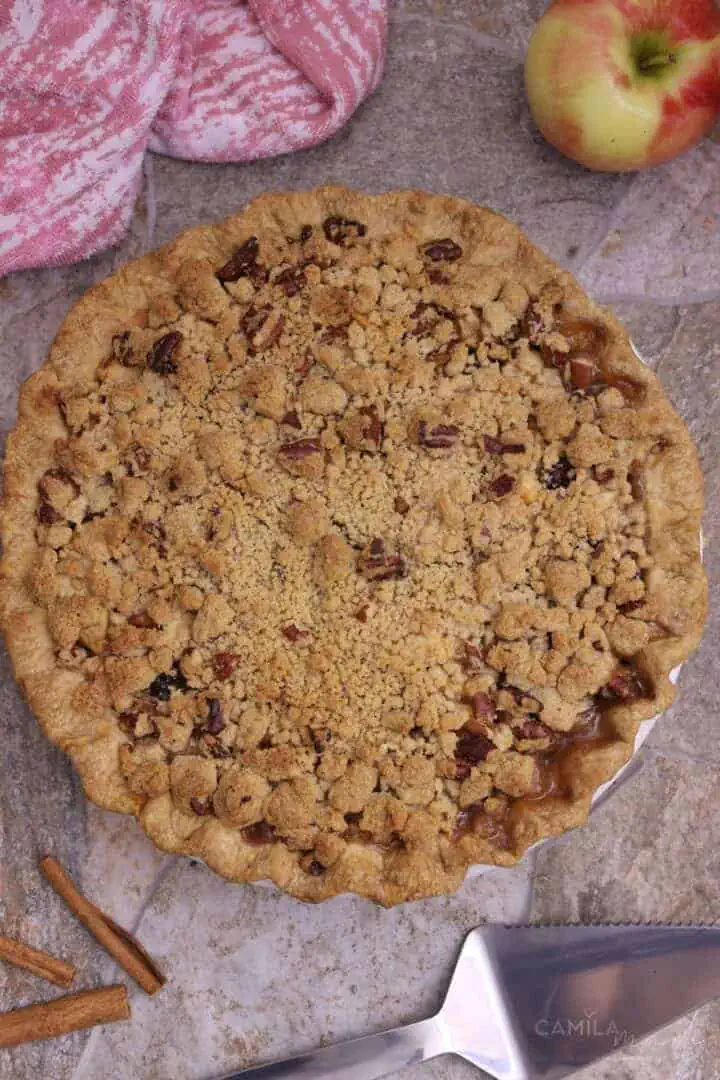 What is
What is 